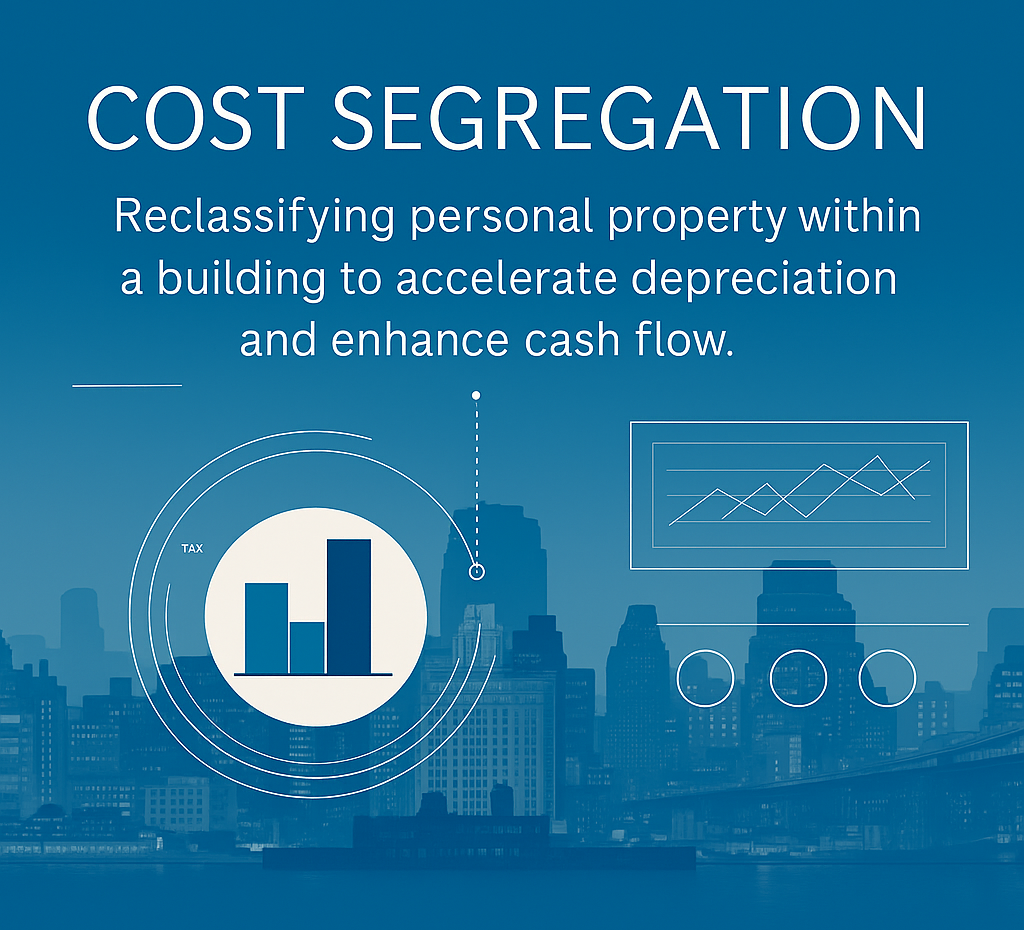Unlock Hidden Tax Savings & Increase Cash Flow
Accelerate Tax & Business Services delivers engineering-based cost segregation studies that identify personal property assets, accelerate depreciation schedules, and reduce current income tax obligations while maintaining comprehensive IRS compliance.
Estimate your savings in minutes: Use our interactive calculator to see your potential tax benefits.
Understanding Cost Segregation
Cost segregation is an IRS-recognized tax strategy that separates personal property assets from real property for depreciation purposes. Instead of depreciating your entire building over 27.5 or 39 years, certain components can be depreciated much faster.
Through a combined engineering and accounting analysis, we identify assets that qualify for accelerated depreciation—reducing your current tax liability and improving cash flow immediately.
These include non-structural building components (like specialty electrical, flooring, millwork, and decorative finishes), exterior site improvements (parking lots, landscaping, signage), and certain building equipment—all of which can be depreciated over 5, 7, or 15 years.

Accelerated Depreciation Strategy
The primary goal of a cost segregation study is to identify all construction-related costs that can be depreciated over a shorter tax life (typically 5, 7, or 15 years) rather than the traditional 27.5 or 39 years. This IRS-recognized strategy accelerates depreciation, creates larger deductions in the early years of ownership, and ultimately frees up cash for reinvestment and growth.
Accelerated Depreciation
Reclassify assets into shorter depreciation periods (5, 7, or 15 years) to maximize early-year deductions and reduce tax liability.
Improved Cash Flow
Reduce current tax obligations and free up capital for operational needs, expansion initiatives, or strategic investments.
Retroactive Application
Apply studies to properties placed in service in prior years to capture missed depreciation using an IRS-approved §481(a) catch-up adjustment—without amending prior returns.
Additional Benefits
Beyond accelerated depreciation and improved cash flow, a Cost Segregation Study can support lower assessed values in some jurisdictions, sharpen insurance valuations, and strengthen risk management—often reducing total insurance spend and improving negotiating leverage.
- Property tax appeal support and assessment reduction strategies
- Precise replacement-cost estimates for insurance purposes
- Proactive maintenance planning and lifecycle analysis
- Flexible coverage options tailored to asset depreciation schedules
Typical Results From Cost Segregation
On average, 25%–35% of total property cost is reclassified into 5, 7, or 15-year depreciation categories.
A typical $2M property often generates $100,000+ in additional first-year depreciation deductions.
Benefits are realized immediately—accelerated deductions reduce your current-year tax liability.
*Results vary based on property type, acquisition date, and construction details. Contact us for a personalized estimate.
Property Types We Serve
Cost segregation delivers significant benefits across virtually all commercial and residential property types.
Multi-Family Apartments
Typically 30%+ reclassification potential
Office Buildings
Strong results for tenant improvements
Retail & Shopping Centers
High fixture and site improvement content
Hospitality & Hotels
Often 35%+ due to FF&E and finishes
Medical & Dental Offices
Specialized equipment qualifies
Industrial & Warehouse
Site improvements often overlooked
The Process
Document Review
Analyze construction costs, architectural drawings, invoices, and fixed asset records.
Site Inspection
Conduct comprehensive property walkthrough to identify qualifying assets.
Asset Reclassification
Assign assets into 5-year, 7-year, or 15-year categories based on IRS guidelines.
Audit-Ready Report
Deliver comprehensive documentation including an Executive Summary and, when applicable, Form 3115.
Eligibility
Cost Segregation is most effective for properties valued above $200,000 and placed in service after 1986.
How to Proceed
The IRS favors detailed, engineering-based studies. Work with experienced professionals to ensure compliance and audit readiness.
Schedule a Consultation
Begin with a complimentary consultation. We review your property type, project scope, and financial objectives to confirm eligibility and potential benefits.
Provide Documentation
Submit available construction costs, architectural drawings, or fixed asset schedules. Even limited records can be used to build a compliant analysis.
On-Site Review
Our specialists walk the property (or use digital documentation if needed) to identify qualifying assets, improvements, and overlooked deduction opportunities.
Deliver Final Report
You receive an engineered, audit-ready report with complete asset reclassifications, depreciation schedules, and IRS documentation for seamless filing.
Audit-Ready & Provider Credentials
Engineering-Based Studies
Our studies are prepared by specialized cost segregation professionals and reviewed in coordination with your CPA or tax advisor for technical accuracy.
Audit-Ready Documentation
We provide comprehensive documentation that meets IRS requirements and supports your filing with Form 3115 preparation.
Works With Your CPA
Keep your existing accountant—we collaborate seamlessly with your tax team and provide all necessary supporting schedules.
Case Study
Property: 150-unit apartment complex acquired in 2019
Purchase Price: $18.5 million
Ready to maximize your property tax deductions?
Schedule a complimentary cost segregation assessment. Our engineering specialists will evaluate your property, estimate potential tax savings, and prepare comprehensive, audit-ready documentation. Expert-engineered, IRS-compliant studies.
Book Consultation →
